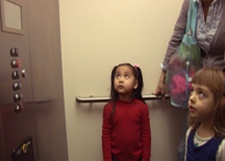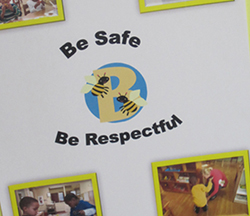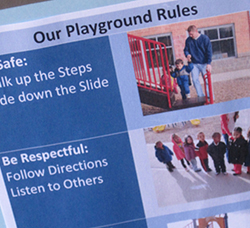Teaching children how to be safe is an important part of your job. Designing effective rules can be an important step in helping keep children safe. In this lesson you will learn about why rules are important, the characteristics of effective rules for preschool children, and strategies for teaching rules to young children.
Secondary tabs
- 确定对学龄前儿童有效的规则。万博体育全站app
- 区分规则和期望。
- 为学龄前教室创建有效规则。万博体育全站app
- 解释如何向学龄前儿童教授规则。万博体育全站app
Learn
Know

Rules are the guidelines that help all of us know how to act in different situations. Sometimes the rules are clearly stated. They might even be posted in writing:
- Keep your seatbelt fastened at all times on the airplane.
- You must be 18 years old to vote.
- 您必须在住宅区每小时25英里。

Other times, the rules are not clearly stated or posted. As adults, we have come to know what is expected of us:
- Wait in line quietly at the grocery store checkout.
- Face the front in an elevator.
- Say, “Hi” when someone greets you.
这些行为是表示尊重或友好的例子。没有人专门教导我们,面对前面是尊重,并在电梯上给别人个人空间,但我们已经了解这一点。

还有其他时候,我们学习了行为的方式,使自己或他人安全。似乎有人似乎不得不告诉我们做这些事情。然而,当你觉得回到童年时,可能有人提醒你做这些或类似的事情:
- Walk when carrying hot coffee.
- 支持园艺设备,就像耙子一样,而不是让他们躺在草地上。
- Turn skillet handles so they don’t stick out where people might bump them.
我们的父母或照顾者可能会告诉我们这些behaviors. We have picked up on what others are doing and model their behaviors. Young children are just beginning to learn what it means to be in large groups and public places. They are also just beginning to learn that their behavior affects others. Preschool children live in the here and now; they do not plan their actions or think about consequences the way adults do. It is our job as adults to teach children how to keep themselves and others safe. Teaching children a small number of safety rules is an important part of your job as a preschool teacher.
看到
Effective Rules or Expectations
Rules are just one part of a larger plan for keeping children safe. Remember that rules work side-by-side with other parts of good early childhood teaching: a well-designed environment, appropriate learning activities, and nurturing relationships. Rules are guidelines or reminders about what it means to be a member of the classroom community. Effective rules for preschoolers reflect what we know about how young children learn (Fox, Jack, & Broyles, 2005):
- Rules should be short and clear. Preschoolers understand short sentences best. A common example is “Use walking feet.” Can you see how this is easier to understand than a sentence like, “When we are in the classroom, you should always walk so you stay safe?”
- Rules should be stated positively. Preschoolers have a hard time connecting their behavior to “not to” or “don’t” statements. Therefore, rules should be stated as what children should do (use gentle touches) rather than what they should not do (don’t hit).
- 规则的数量应限制。万博体育全站app学龄前儿童只能在他们的内存中占据少量项目。最好只教三到五个规则。
- Rules should be posted along with pictures. Preschool children are only beginning to learn that print has meaning. Use pictures or drawings to help children understand what rules mean.

教室有两种类型的指南havior: expectations and rules. Expectations are general characteristics or ways you would like children to behave. Examples might include:
- Be respectful.
- 注意安全。
- Be friendly.
- 尊重他人。
- Respect the environment.

Rules help define exactly what expectations mean. Rules are our way of communicating to children what it means to “be respectful.” Examples of rules are:
- Use walking feet.
- Clean up toys when you finish with them.
- Use gentle hands.
- Follow directions.
作为教师,您可以开发期望,规则或两者。但请记住,幼儿仍在培养他们的认知技能。保持规则或期望简单很重要。不要害怕使用像“尊重”这样的复杂词汇。如果你教导意味着尊重,孩子们会理解它 - 你会以积极的方式扩大他们的词汇!
You have many choices in how you design your classroom rules or expectations:
- 您可以编写规则并向儿童介绍。
- You can write the rules together with the children.
- 您可以使用一组规则您的计划或中心已达成一致。

无论您如何在课堂规则上决定如何,确保他们符合本课程中描述的有效规则的指导方针。孩子们有时建议不符合指导方针的规则。例如,孩子们可能会建议规则“不要爬上操场上的围栏”或“不要咬人”。您可以为这些建议做好准备,并帮助孩子以积极的方式重新制糊这些。你可以说,“好,是对的,我们不爬篱笆。我们该怎么做?“您可以指导他们走向像“保持脚在地上”或“只爬上梯子和楼梯”的规则。
Do
When Teaching Rules
Model
我们帮助孩子学习的第一种方式是成为强大的榜样。我们应该让我们的规则每天都在课堂上生命。您可以全天模拟尊重,安全,团队合作以及许多其他行为。
How many times have you seen an adult raise his or her voice to tell children to quiet down? Take a minute to think about the message children receive in that scenario. Make sure your rules apply to everyone: children and adults. Make a point of thinking out loud about the rules. As you clean up a spill on the floor, you might say, “I want to be safe and responsible. I’m going to clean this spill before someone slips.” All of the adults in the room can get involved. Practice solving problems together in front of the children. Can you think of other times you can model the rules for children?
Post
A well-designed environment prevents safety problems. Your rules should be a part of the environment. Post rules where you are likely to need them: the large group area, the playground, the hallway. When your rules are posted for children to see, you can refer to them quickly and easily. Children can remind themselves and others of the rules, as well. Post your rules at eye level for the children. Be sure to include pictures or drawings of the rules. You can use clip art, hand drawings, or photos of the children.
提醒和加强
Once you have developed effective rules on your own or with the class, it is important to remember to use them! Posting rules, even with a picture, is not enough. We have to actively teach young children how and when to follow the rules. Here are some ideas for teaching the children how to follow the rules:
探索
有时我们会遇到讲述孩子不做什么的坏习惯。下载并打印Rules Activity。看看课堂规则。重写它们,所以它们被肯定地说明。然后将您的想法与建议的回复进行比较。
Apply
Use this form to develop rules for your own classroom. If you already have rules, use it to decide whether they are strong rules for preschool children. Print this form and discuss the materials with your team.
Glossary
| Term | 描述 |
|---|---|
| expectation | An expectation is a general description of the characteristics and behaviors you would like children to have. Expectations usually apply to every setting a child may be in. Examples are “Be respectful,” “Be kind,” or “Be a good friend.” |
| rule | A rule is a specific way of behaving in a certain setting. Examples are “Use walking feet,” “Use inside voices,” “Share with your friends.” |
演示
Center on the Social and Emotional Foundations for Early Learning.http://www.vanderbilt.edu/csefel
Fox, L., Jack, S., & Broyles, L. (2005). Program-Wide Positive Behavior Support: Supporting Young Children’s Social-Emotional Development and Addressing Challenging Behavior. Tampa, Florida: University of South Florida, Louis de la Parte Florida Mental Health Institute.
关于积极行为干预和支持的技术援助中心。http://www.pbis.org.
社会情绪化干预技术援助中心。http://www.challengingbehavior.org.



